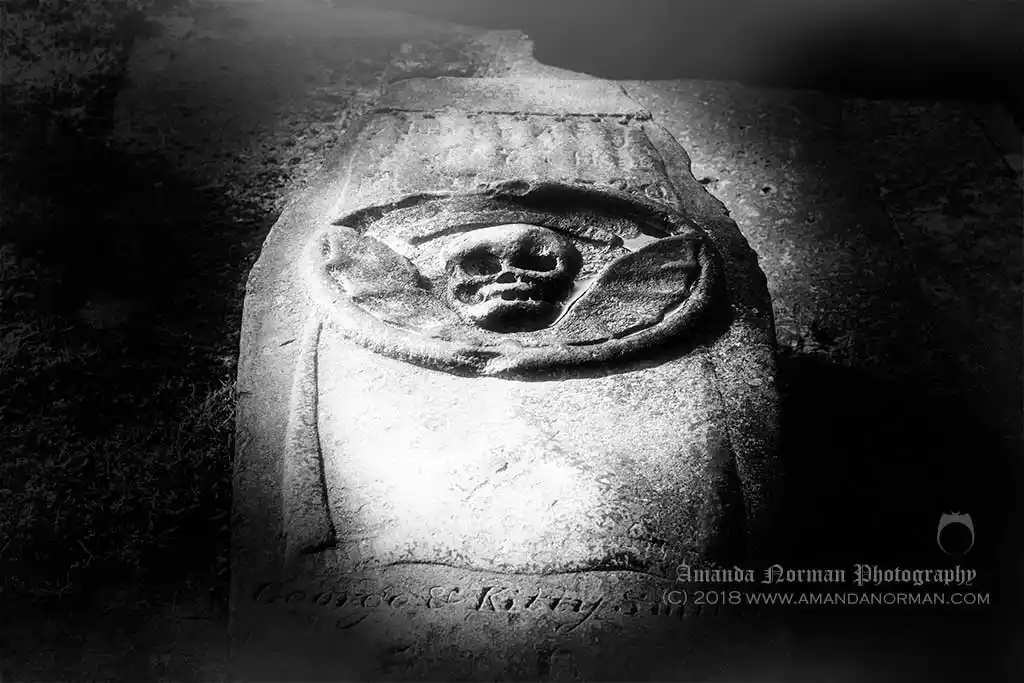George and Kitty Smith of Billinge in Merseyside most certainly still speak to us from their spectacular grave found in St Aidan’s churchyard. With this being such a grand example of Memento Mori, I began my quest to find out more about the Smiths. My research didn’t disappoint me as I began reading about the legend of George and Kitty Smith.

This coffin-shaped grave within the grounds of St Aidan’s Church in Billinge, will draw you in especially if you have a curious mind. Mine was in overdrive when I viewed the magnificent art on top. Shown above, you can clearly see a very fine example of Memento Mori art. Furthermore, a grave like this shows that this couple were of good standing to afford a masterpiece like this.
Centuries ago with the various plagues, death was a part of everyday life with mortality rates being a lot higher than these days. Also, it was common place for the body to rest at home until the day of burial. Along with this, religious beliefs were also strong. Therefore, Memento Mori served as a reminder to all that death could arrive within the hour, and that all must prepare for a ‘good death‘. If you like Memento Mori, visiting my gallery is a must!
However, more about the symbology later. Let’s begin with a romantic tale of love and death. Following this, I will also reveal George and Kitty Smith’s ‘real’ message from beyond the grave, to YOU!
Billinge Legend of George and Kitty Smith
This legend begins one day in 1720.
While taking a break from his work in the quarry, George Smith was bitten by a snake. Subsequently, he lost his life leaving Kitty Smith a widow. Eventually, Kitty would join George upon her deathbed with the re-opening of the grave.
This legend is centuries old and has been altered many times. Sometimes you will hear that it was Kitty who was bitten by a snake and subsequently died. George Smith succumbed with grief, then took his own life and together they were buried here.
Isn’t this such a lovely example of eternal love that has lasted centuries?
Although a wonderful legend that has the making for an excellent tale of Gothic horror, the symbology of a snake eating its own tail, is not a symbol representing death from a snake bite. The snake clearly more visible in the photograph below, is a classic symbol of memento mori.
Their message to you beyond their grave
This coffin-shaped tomb has the date of 1720. Also, a lot of the writing is illegible apart from the words ‘George & Kitty Smith‘.

Memento Mori in Latin means Remember that YOU will die!
Now, I’m guessing that considering this is the only example of memento mori in this graveyard, George and Kitty Smith must have been wealthy. Perhaps they had wealthy friends or family to afford an ever-lasting reminder like this. Their message to the living is…
No matter what your status is in life, we all receive DEATH and our souls will be resurrected in the afterlife.
You will see below that I have listed each symbol seen on the coffin. Together with its meaning, we can decipher the true story of life and death.
- The skull represents death that comes to us all
- The wings represent the ascent to Heaven or the afterlife. Together, the skull and crossbones are what we call cemetery death heads.
- Ouroborus (snake-eating tail). This is an ancient symbol representing eternity and the cycle of life, and death
- Above the winged skull motif, you can see a curtain or drapery. Drapery seen on headstones usually depicts the veil between life and death, and the crossing of that plane. To others, it can symbolise God’s protection until Resurrection. We often see drapery covering urns in Victorian cemeteries.
References

